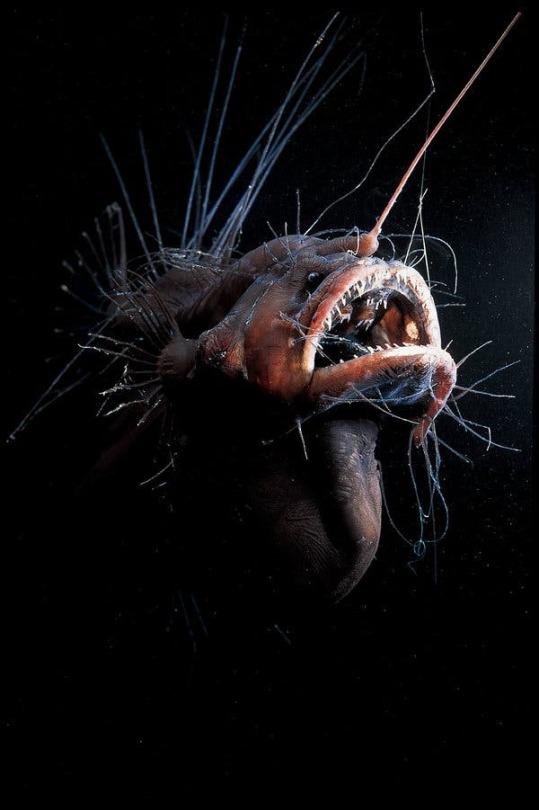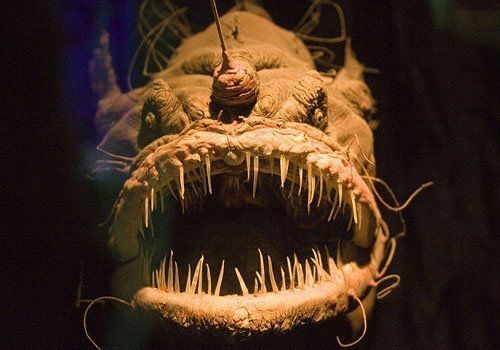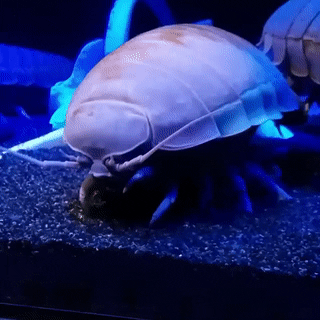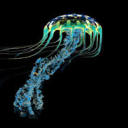Fanfin Seadevil


Fanfin Seadevil
Caulophyyne jordani
The Fanfin Seadevil is an ugly, deep fish that is covered in gnarled skin and long sensory filaments. The sensory filaments allow this species of anglerfish to detect movement in the water; this helps the Fanfin find and lure its prey. Furthermore, this deformed monstrosity can be found floating between 700m to 3000m in the ocean.
Photo credit: https://www.nytimes.com/2019/07/29/science/anglerfish-bioluminescence-deep-sea.html
http://www.robotspacebrain.com/alien-creatures-of-the-mariana-trench/
More Posts from Bioluminescentoceangoddess and Others


Giant Isopod
Bathynomus kensleyi
The Giant Isopod is an unsettling deep sea creature that crawls along the ocean floor scavenging for animal remains and detritus. These invertebrates are part of phenomenon known as abyssal gigantism, which is the tendency for deep-sea dwelling invertebrates to be larger than their shallower-water counter parts. The Giant Isopod is found between 310m to 2140m in the ocean.
Photo credit
https://seatrench.tumblr.com/post/615873390014791680/giant-isopod-bathynomus-sp-source
https://alchetron.com/Giant-isopod


Spookfish
Winteria telescopa
The Spookfish’s eyes act as a telescope and are designed to maximize light in the deep ocean. Its eyes contain rod cells that help distinguish between ambient light and bioluminescent light. This adaptation helps avoid predators and catch prey.
Picture Credit: https://www.natureplprints.com/deep-sea/deep-sea-fish-winteria-telescopa-15230734.html
Pyrocystis fusiformis is a common plankton that produces bioluminescence. Not exactly a marine animal, but an amazing organism that produces bioluminescence. So, I thought it was worth sharing on this page.



Pyrocystis fusiformis
Pyrocystis Fusiformis is a marine dinoflagellate that is non-motile and has a short life cycle (5-7 days). When disturbed, the dinoflagellate displays vibrant, blue bioluminescence. The bioluminescence is design to startle grazers, or cause them to glow, making them more vulnerable to predators. During the day, it uses photosynthesis to produce its own food, and it produce bioluminescence at night. Furthermore, it fixes carbon from the ocean and produces oxygen for the marine animals that live there. All in all, I find this diamond shaped plankton to be unique and beautiful.
Photo credit: https://fineartamerica.com/featured/2-bioluminescence-of-pyrocystis-fusiformis-gerd-guentherscience-photo-library.html
https://exploringtheinvisible.com/2013/11/21/c-mould-new-acquisition-pyrocystis-fusiformis/
https://www.flickr.com/photos/13084997@N03/32823053106


Pigbutt worm
Chaetopterus pugaporcinus
The Pigbutt worm or the flying buttocks of the sea is spotted floating between 965 m to 1300 m in the deep ocean. It is actually a polychaete (polly-keet) worm species that burrows in the ground as an adult, and floats around the ocean as a baby. The worm feeds itself : by creating a balloon of mucus; collecting particles on the mucus; and then consuming the particles. It is the rarest and thickest worm in the deep ocean, for only ten have been spotted.
Photocredit: https://roaring.earth/pigbutt-worm/


Giant Bell Jelly
Scrippsia pacifica
The Giant Belly Jelly has 256 tentacles attached to a gelatinous bell-shaped base. Like most cnidarians, the Giant Belly Jelly uses specialized stinging cells called nematocysts to catch its prey. When fish and other prey swim into its tentacles, the sensory projection on the cnidocyte (cell that holds the nematocysts) is activated. Then the nematocysts and barb are released, hitting the vulnerable prey and releasing a toxin into the prey’s body. The Giant Bell Jelly is found at 400 m in the ocean. It is related to the jellyfish, but it is categorized as a Hydrozoa (similar to the Portuguese- man-o-war)
https://vimeo.com/42551565
Photo Credit: https://www.pinterest.cl/pin/467107792572034837/
https://courses.lumenlearning.com/ivytech-bio1-1/chapter/phylum-cnidaria/


Cigar Comb Jelly
beroe forskalii
The Cigar Comb Jelly is a gelatinous ctenophore that is marveled by many due to its sparkling bioluminescence. It tends to elegantly float around 120 m in the ocean. It uses unique, hair-like structures called ctens to move horizontally in the ocean. It also swims in a spiral pattern before consuming zooplankton in the ocean.
Photo credit: https://www.wrobelphoto.com/gelatinouszooplankton/h25347306
https://www.flickr.com/photos/a_migotto/27227530815


Piglet Squid
Helicocranchia pfefferi
The Piglet Squid is a very small and delicate, transparent squid. It is found at depths between 400 to 1000 m. It has an unique siphon that is used for jet propulsion and it resembles a pig muzzle. The young piglet squids tend to live close to the surface, and steadily migrates downward as they grow. This behavior is called ontogenetic migration.
Photo credit: http://photo.cctv.com/2019/07/23/PHOAKMEBh8xJRaHXEUIGx8kE190723.xml
https://www.ourbreathingplanet.com/banded-piglet-squid/

Pram Bug
Phronima sedentaria
The Pram Bug is a deep sea amphipod that is located between 200 to 1000m in the ocean. It has a translucent exoskeleton and can see primarily blue light. It is also is contained in a hollowed out barrel that is used for protection and to house babies. The image above is a female pram bug carrying its young.
Photo Credit:https://ocean.si.edu/ocean-life/invertebrates/phronima-female-and-young

Scaly Dragonfish
Stomias Boa
The Scaly Dragonfish is about 32cm long and found at depths between 200 to 1500m. The long purple barbel on its chin is used to lure in prey. When the pery gets close enough, it swings its jaws forward swallowing the prey whole.
Photo credit: https://alchetron.com/Stomias
Video on the fish: https://www.youtube.com/watch?time_continue=69&v=9oB_61aI2iQ&feature=emb_title


Googly-eyed glass squid
Teuthowenia pellucida
The Googly eyed squid is a rare oddity that is found in the southern hemisphere. It has a large, spherical head that is filled with water and teeny, tiny tentacles that help propel it through the water. If it comes across a predator, it deflates its head and draws its tentacles into its cavity. On the other hand, it may also fill the cavity with water to increase its size, and intimidate the predator. If all fails, it will ink and try to escape through the darkness. Furthermore, baby squids can be found at the surface (0-600m); then slowly migrate downwards as they mature into adults (1600-2500m).
Photo credit: http://animaladay.blogspot.com/2011/07/googly-eyed-glass-squid.html
https://faunafabula.tumblr.com/post/5999675353/googly-eyed-glass-squid-teuthowenia-pellucida
-
 amorxsomnia liked this · 11 months ago
amorxsomnia liked this · 11 months ago -
 nerdypersonamongerscissors liked this · 1 year ago
nerdypersonamongerscissors liked this · 1 year ago -
 wildernestt reblogged this · 2 years ago
wildernestt reblogged this · 2 years ago -
 unknowinglysenescent reblogged this · 2 years ago
unknowinglysenescent reblogged this · 2 years ago -
 unknowinglysenescent liked this · 2 years ago
unknowinglysenescent liked this · 2 years ago -
 oceanfatherfigure reblogged this · 2 years ago
oceanfatherfigure reblogged this · 2 years ago -
 littlemissbigears reblogged this · 2 years ago
littlemissbigears reblogged this · 2 years ago -
 808beat liked this · 3 years ago
808beat liked this · 3 years ago -
 rabbitsartcorner liked this · 3 years ago
rabbitsartcorner liked this · 3 years ago -
 sothatidostuff reblogged this · 3 years ago
sothatidostuff reblogged this · 3 years ago -
 ryzomeriseup liked this · 3 years ago
ryzomeriseup liked this · 3 years ago -
 moonflower-pies reblogged this · 3 years ago
moonflower-pies reblogged this · 3 years ago -
 moonflower-pies liked this · 3 years ago
moonflower-pies liked this · 3 years ago -
 sleppybitch liked this · 3 years ago
sleppybitch liked this · 3 years ago -
 jerrielzapata liked this · 3 years ago
jerrielzapata liked this · 3 years ago -
 acolorcollective liked this · 3 years ago
acolorcollective liked this · 3 years ago -
 revolucia liked this · 3 years ago
revolucia liked this · 3 years ago -
 bluepurpledot liked this · 3 years ago
bluepurpledot liked this · 3 years ago -
 in-soft-grass liked this · 3 years ago
in-soft-grass liked this · 3 years ago -
 clearwingcauliflower liked this · 3 years ago
clearwingcauliflower liked this · 3 years ago -
 sincurve liked this · 3 years ago
sincurve liked this · 3 years ago -
 lavendermoon333 liked this · 3 years ago
lavendermoon333 liked this · 3 years ago -
 rodolfo9999 liked this · 3 years ago
rodolfo9999 liked this · 3 years ago -
 slcr303 liked this · 3 years ago
slcr303 liked this · 3 years ago -
 larvacea reblogged this · 3 years ago
larvacea reblogged this · 3 years ago -
 georgewalt liked this · 3 years ago
georgewalt liked this · 3 years ago -
 neonhearted liked this · 3 years ago
neonhearted liked this · 3 years ago -
 claysenpai reblogged this · 3 years ago
claysenpai reblogged this · 3 years ago -
 claysenpai liked this · 3 years ago
claysenpai liked this · 3 years ago -
 low-level--00 reblogged this · 3 years ago
low-level--00 reblogged this · 3 years ago -
 low-level--00 liked this · 3 years ago
low-level--00 liked this · 3 years ago -
 trans-lycion liked this · 3 years ago
trans-lycion liked this · 3 years ago -
 ophiocordyceps liked this · 3 years ago
ophiocordyceps liked this · 3 years ago -
 mr-crix liked this · 3 years ago
mr-crix liked this · 3 years ago -
 creaturedeityendless liked this · 3 years ago
creaturedeityendless liked this · 3 years ago -
 cannabowlistic reblogged this · 3 years ago
cannabowlistic reblogged this · 3 years ago -
 la-vie-en-lys reblogged this · 3 years ago
la-vie-en-lys reblogged this · 3 years ago -
 la-vie-en-lys liked this · 3 years ago
la-vie-en-lys liked this · 3 years ago -
 vaguelyexistingcloud liked this · 3 years ago
vaguelyexistingcloud liked this · 3 years ago -
 lraquel liked this · 3 years ago
lraquel liked this · 3 years ago -
 chendaiwei liked this · 3 years ago
chendaiwei liked this · 3 years ago -
 cernunnos1990 reblogged this · 3 years ago
cernunnos1990 reblogged this · 3 years ago

Bioluminescence is a chemical reaction that produces light. Many deep sea animals use bioluminescence. This blog is dedicated to educating the public about the amazing creatures that thrive in the deep sea.
57 posts